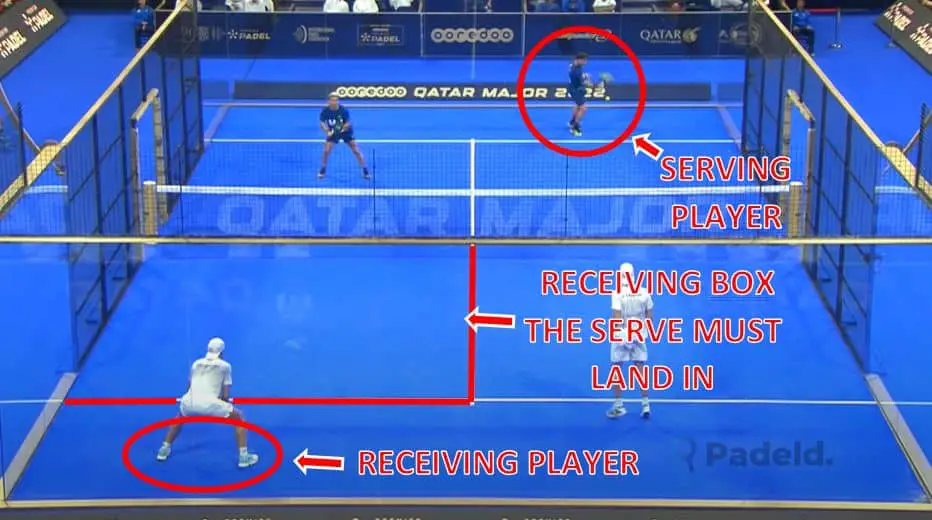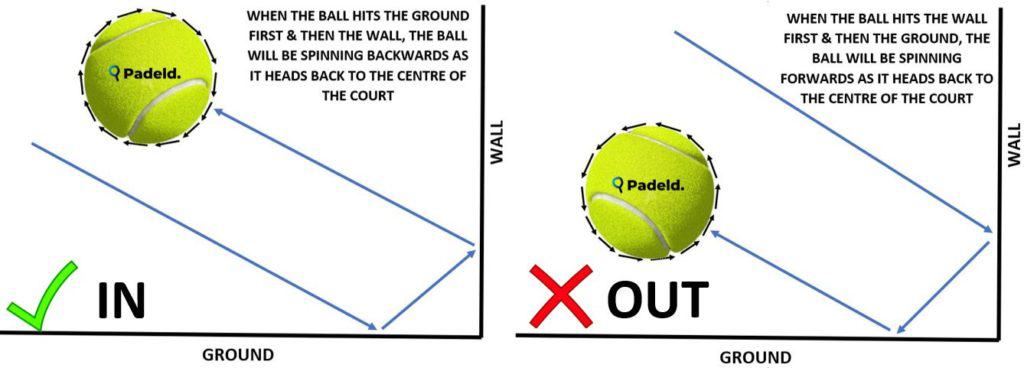When I first watched padel being played back in 2019, I remember that I didn’t have a clue what a legal shot was! I vividly remember watching a game between Lebron/Galan and Navarro/Lima and saw all sorts of things happening. The ball was being smashed into the back wall, into the fences, outside the cage itself, and it was even being hit from outside the cage back into play through the access points in the side of the cage. The key to understanding a racket sport like padel is knowing what is classed as ‘in’ or ‘out’ by the umpire – so I was immediately confused!
I imagine that lots of newcomers to padel have gone through the same confusion that I felt back then, so I thought I would write this post to explain it all thoroughly. Trust me, once you know these rules, the whole sport will seem a lot simpler!
So, what is classed as ‘in’ and ‘out’ in Padel?
During a rally, a players shot must travel over the net and bounce on the ground on the opponent’s side of the court to be ruled ‘in’. If the ball a) bounces on their own side of the court, b) hits any of the walls on the opponent’s side of the court, or c) lands outside the court before this happens, the ball is out.

When the serve is being hit, the rules are ever so slightly different. A serve must be hit into the receiving box that is diagonally opposed from the serving player. You can see an example of this in the diagram below. If the serving player does not land the ball in this box, then the ball will be called out. In this situation the serving player would need to try to land the ball in the receiving box again by hitting a ‘second serve’. If the ball is called out again, the serving side will lose the point.

Let’s now run through a few quick examples so that we can properly establish what the rules are…
Firstly, imagine that the ball has been served by team A. The serve lands in the correct receiving box and is then returned by a member of team B who plays a lob shot. The lob lands inbounds at the back of team A’s court before bouncing up and hitting the back wall. Then, a member of team A plays a powerful shot that flies into the net. Once the ball hits the net, it bounces back on their own side of the court. In this case, because the ball did not get over the net and land on the opponent’s side of the court, the ball was no longer in play. Therefore, team A lost the point.
For this second scenario, imagine once again that the ball has been served by team A. The serve lands in the correct receiving box and is returned quickly by the receiving player on team B. Unfortunately, the return wasn’t hit very accurately, and the ball goes straight into the metallic fence on team A’s side of the court before it bounces on the ground. This shot from team B is regarded as out because it did not hit the ground on the opponent’s side of the court before it hit their wall. Hitting the ball into the wall of your opponent without the ball bouncing first will mean that you lose the point.
For my final example, imagine that the ball is served by team A and it lands in the receiving box. The receiving player on team B immediately hits the ball into their own glass wall in a way that it will bounce off and travel over the net back onto team A’s side of the court. Team A’s players have now moved forwards towards the net, and once the ball is on their side, one of the players hits a powerful smash shot back onto team B’s side of the court. Unfortunately for team A, the smash shot travels slightly too long and hits the glass wall at the back of the court before it makes contact with the floor. This shot is ‘out’ because it needed to bounce on the ground on team B’s side of the court before it hit the glass!
Also, remember that padel players are allowed to hit the ball into the glass wall on their own side of the court, as long as the ball ends up travelling over the net and landing on the opponent’s side of the court after this happens!
How Can You Tell If A Ball Is In Or Out In Padel?
In most cases, it will be incredibly easy to spot whether a shot is in or out. But in rarer cases where it’s very hard to tell, there are a couple of simple little tricks you can use to judge the shot accurately!
So, what rare cases am I referring to here? Well, when a shot causes the ball to bounce in close proximity to the wall, it’s incredibly hard to see whether the ball bounced on the floor or off the wall first. This means that it’s hard for players to tell whether the ball was in or out! Also, most recreational padel games don’t have neutral individuals like umpires that are responsible for judging things like this – therefore it’s left up to the players! Thankfully, there’s a pretty easy way to spot whether a ball has hit the ground or the wall first – and I’ll share it with you now!
Basically, if a shot hits the ground before it hits the wall, the ball will be spinning backwards as it bounces off the wall. If a shot hits the wall before it hits the ground, the ball will be spinning forwards as it bounces away from the wall. So, if a ball has backspin on it after it has made contact with the ground and the wall, this shot almost certainly hit the ground first – meaning that the shot was in! The diagrams below should make this a little easier to understand!

Additionally, a ball that is out (one that hits the wall and then the ground) is much more likely to rebound from the ground at a low angle. A shot that is in (one that hits the ground first and then the wall) is much more likely to bounce higher as it rebounds back towards the centre of the court.
Conclusion
Knowing which shots are in and which shots are out is a huge part of understanding the game of padel. If this was something that you were struggling to understand, I hope that this post has helped you get a bit more clarity on it! Padel is a very simple game, and the more you watch it the better you’ll understand it!
If you have any other questions about the sport, I may have answered them here at Padeld.com. Feel free to have a browse through the site to see if I can help you with anything else!
